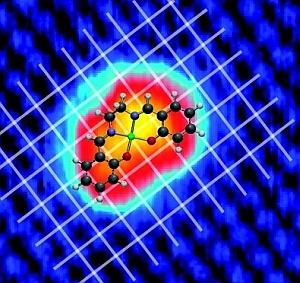

11/29/2010

© 2010 ACS
By combining high-resolution atomic force microscopy (AFM) with extensive theoretical modeling, Thomas Trevethan and Alexander Shluger from the WPI-AIMR at Tohoku University, along with co-workers from the University of Hamburg in Germany and University College London in the UK, have determined exactly where a magnetizable metal–organic complex attaches to an insulating surface — a critical step in the development of applications like ultra-dense molecular logic circuits1.
To use single molecules as tiny device elements, scientists must first deposit them on insulating surfaces, such as sodium chloride, to ensure that they are electrically isolated. These insulating surfaces, however, make it exceptionally hard to image the locations and orientations of adsorbed molecules — factors that can have a considerable influence on overall device behavior.
One way to achieve atomic-scale imaging of insulators is with AFM, a technique that uses an atomically ‘sharp’ oscillating tip to physically trace out surface topography. Even so, achieving simultaneous resolution of the structure of both the adsorbed molecules and the substrate underneath is no easy task, according to Trevethan. “Usually, when the microscope tip is brought close enough to the surface to resolve individual atoms, the adsorbed molecules are pushed out of the way due to strong interaction with the tip itself,” he explains.
The researchers solved this problem by coating a supersharp AFM tip with a layer of chromium metal atoms that interact favorably with surface chloride ions. The resulting tip is able to resolve the topology of the substrate even while remaining quite far from the surface, and thus does not disturb the adsorbed molecules.
With this new tip, the team studied the adsorption of Co-salen — a cobalt–aromatic hydrocarbon complex that has interesting magnetic properties — on sodium chloride surfaces. After the system was cooled to near absolute zero, the chromium-coated tip produced exceptionally clear images of the adsorbed molecules, which were found to adopt up to sixteen different orientations relative to the underlying ionic lattice (Fig. 1).
To understand why Co–salen has such a range of possible adsorption geometries, Trevethan and colleagues turned to quantum chemical calculations. “Co–salen is quite large and to model it accurately, we would normally have to consider a very big system,” says Trevethan. The researchers designed a novel method that treats only a small part of the surface. This approach revealed that the numerous orientations arose from subtle interplay between the Co–salen complex and the atoms of the underlying ionic surface.
The researchers plan to use their chromium-coated tip to study insulating surfaces with interesting magnetic properties, such as nickel oxide.
Lämmle, K., Trevethan, T., Schwarz, A., Watkins, M., Shluger, A. & Wiesendanger, R. Unambiguous determination of the adsorption geometry of a metal–organic complex on a bulk insulator. Nano Letters 10, 2965–2971 (2010). | article
This research highlight has been approved by the authors of the original article and all information and data contained within has been provided by said authors.